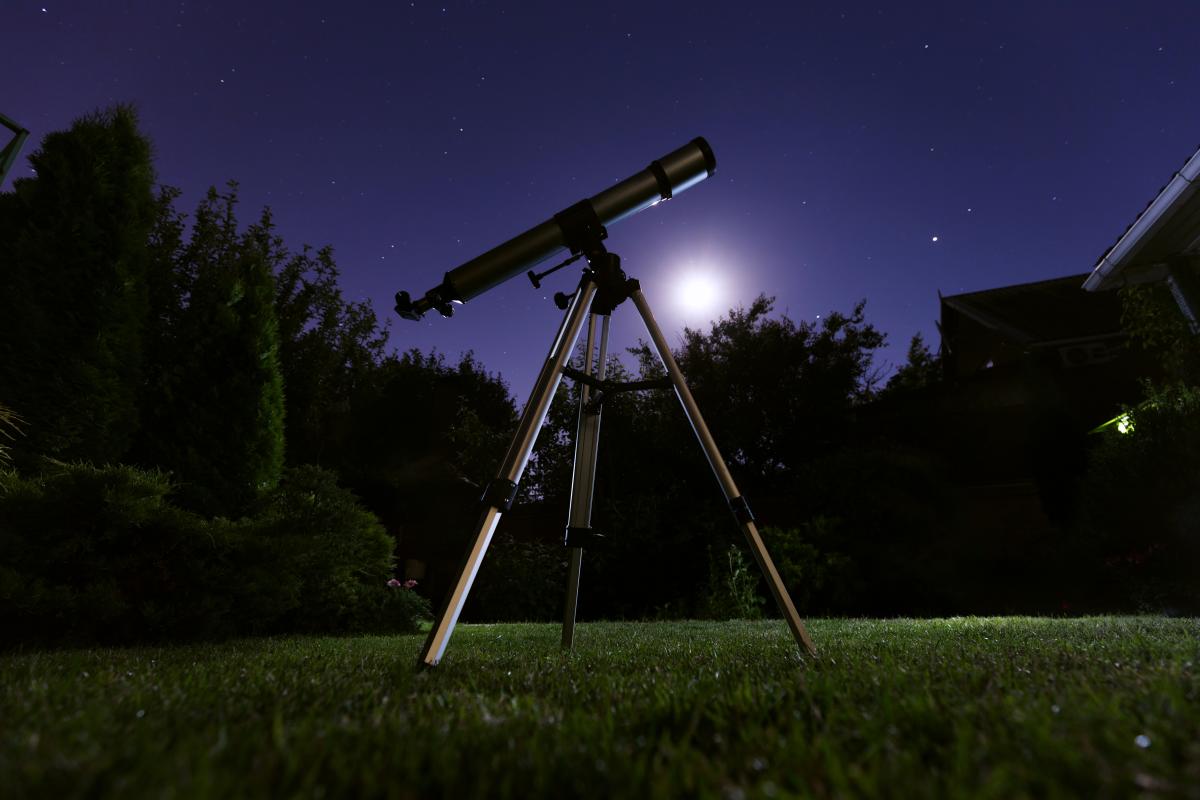Backyard Astronomy For Beginners

The universe has infinite wonders just waiting to be explored. When you look up at the night sky, you can see an endless canvas of stars and planets with nothing but the naked eye. Beyond the naked eye, there's much to be seen with the assistance of a telescope or even a pair of binoculars. If you're new to stargazing, it's easy to feel overwhelmed as you try to learn everything, from what to look for to what equipment you should use. As you begin your journey into astronomy, this guide can help you understand what's out there and how to make every stargazing experience a great one.
Let's Talk About The Cosmos
The cosmos, or the known universe, is inconceivably large. While its actual size is indeterminable, scientists believe the furthest observable parts of our universe to be approximately 46 billion light-years away. However, the universe is ever-expanding and as such, the dimensions and distances between earth and the ends of the observable universe can be expected to change as time progresses.
What's Up There?
Space is defined as the area that sits 60 miles above the earth's surface and beyond. While most of us know a little about our solar system, that is, the planets that revolve around our sun, what's not fully known is how many other planets are out there. According to NASA, more than 5,000 exoplanets, or planets that lie outside of our own solar system, are currently orbiting stars throughout the universe. As astronomers continue to explore space, that number continually rises.
Outside of just planets, there's plenty more to see when looking at space, even from your own backyard. Of course, there are plenty of stars and constellations to view, and with the right equipment, you may even be able to see nebulas, far away galaxies, and the moons of other planets. At observatories operated by NASA and other space agencies around the world, astronomers can detect the presence of supermassive black holes, hot gas streams, and other events that generate incredible amounts of energy.
How Scientists Use Observatories And Telescopes To Explore the Universe
Observatories house astronomical telescopes and large equipment to help scientists explore space and study the cosmos. The equipment used in observatories, such as gamma-ray and x-ray telescopes, captures high-energy light bursts and help scientists to detect and understand underexplored parts of our universe, such as supernovas, dark matter, and black holes. While many of these observatories are right here on earth, some are launched into orbit and are constantly sending data back to scientists here on earth, helping us to better understand the infinite space that is our universe.
Further Reading
NASA | How Big is Our Universe?
NASA | Stars
NASA | Observatories
Getting Familiar With The Night Sky
Before spending money on expensive telescopes or other equipment, it's a good idea to take some time to get to know the night sky. As a beginner astronomer, there's lots to learn and the good news is that you don't necessarily need to invest in new equipment to start viewing space.
Viewing The Sky With The Naked Eye
As you begin your journey into astronomy, the easiest way to start is by simply looking up on a clear night. The best place to view the sky is somewhere dark and far from city lights. While viewing the sky, you'll probably find that the longer you look up, the more you can see. It can take as long as 30 to 40 minutes for eyes to fully adjust to the darkness and enable you to clearly see the night sky. As they to the darkness and nighttime use, you'll be better able to see small details in the sky, such as shooting stars, planets, and constellations that lie deep in outer space.
What you can see in the night sky without assistance depends largely on the time of year, the weather, and the part of the world you're viewing it from. Throughout much of the year, you can spot Mercury, Venus, Jupiter, Saturn, and Mars if you look toward the right part of the sky. The moon and the stars can be easily seen without a telescope, and if you're in the southern hemisphere, you may be able to see the Large and Small Magellanic Clouds, two irregular galaxies that orbit the Milky Way.
Using A Star Chart To Discover Constellations
Star charts are maps of the night sky that enable you to locate stars, planets, and constellations. Different charts are made for different seasons, so it's important to use one that correlates with the time of year you plan to stargaze. Using these charts, you can map out your location relative to the stars you see and follow along to discover just what's hovering over you in the cosmos.
Here are some constellations you should be able to find easily while using your star chart:
Ursa Major: Also known as The Big Bear, Ursa Major is the constellation we often find when searching for The Big Dipper, which makes up the head and neck of the big bear.
Ursa Minor: Not far from Ursa Major is Ursa Minor, or The Little Bear. Featuring Polaris (the North Star), Ursa Minor also features the Little Dipper, which makes up the tail and side of the little bear.
Cassiopeia: Cassiopeia boasts a W shape and features three stars with known planets, as well as the Heart Nebula and the Soul Nebula.
Orion: Orion is known as The Hunter. It features three bright stars that form a straight line, or the hunter's belt, as well as Betelgeuse, which is a bright star located on the underarm of the hunter.
Taurus: Just above Orion is Taurus, also known as The Bull. It features Aldebaran, a large red star, as well as two bright clusters of stars, the Crab Nebula and Pleiades.
Gemini: Best seen just before dawn, Gemini, known also as The Twins, features an almost symmetrical shape. Among its stars are Castor and Pollux, twin stars that give Gemini its name.
Identifying Planets And Satellites
If you're searching for planets and satellites in the night sky, it's best to wait until your eyes have fully adjusted to the darkness. This allows your eyes to fully process the light you see and easily determine whether you're looking at a star, a planet, or a satellite.
Planets vs. Satellites
Before you start searching the sky for planets and satellites, it's important to understand exactly what the terms mean. A satellite is anything that orbits a star, whether it's natural or man-made. That means that the machines that space agencies have launched into orbit to study the universe are satellites, as well as the moon, the earth, and other planets.
The Planets In Our Solar System
Within our solar system, there are eight planets orbiting the sun. There are four rocky planets: Mercury, Venus, Earth, and Mars. These four planets are closest to the sun. Beyond these planets are Jupiter and Saturn, which are gas giants, and Uranus and Neptune, which are ice giants. Pluto, a dwarf planet, lies just beyond Neptune. When you search for planets in the night sky, keep in mind that while they may look like stars at a glance, planets give off still light while stars twinkle. The simplest way to find their location is with a star chart or a stargazing app, and while some can be seen with the naked eye, using a telescope to observe planets in the sky is often far more effective.
Exoplanets
Planets that lie outside our galaxy are known as exoplanets. More than 4,000 exoplanets have been discovered since the early 1990s and that number is continuing to grow as scientists further explore the universe. Although it's rare to see these exoplanets even with the most powerful telescopes, they can sometimes be detected by viewing the stars they orbit. Professional astronomers use several methods to do this, including searching for moments when these stars become dim, which occurs while the exoplanet passes across the front of the star.
Further Reading
University of Michigan | University Lowbrow Astronomers Naked Eye Observer's Guide by Dave Snyder
Farmer's Almanac | Visible Planets Guide
NASA | Our Solar System
Choosing The Right Equipment
Binoculars
A good pair of binoculars can help you take your stargazing to the next level. While binoculars might not help you see all the way to the far corners of the universe, they can help you see stars, nebulas, and satellites in greater detail. Some of the things backyard astronomers report seeing best with binoculars include:
The International Space Station
The Moon
Planets, including Jupiter and Saturn
The Andromeda Galaxy
The Orion Nebula
How To Choose A Pair of Binoculars For Astronomy
When searching for the right pair of binoculars to help you gaze at the night sky, it's best to find a pair that's specifically designed for astronomy. This ensures that the lenses are large enough to allow the appropriate amount of light in, and that the magnification level will be high enough to view the sky in great detail.
If you're not able to find a pair that's made for astronomy, there are several features you'll want to consider.
High aperture/wide lenses — 20 x 80 or 25 x 100 works best
Image Stabilized Binoculars (ISB)
Coated optics for high-contrast views
Comfortable weight/grip
Waterproofing
Telescopes
As your astronomy hobby grows, your desire to see more of the universe will likely grow along with it. Your ability to see beyond our galaxy and deep into the cosmos depends on the equipment you have at your disposal. A good-quality telescope can help you view the Milky Way's stars and planets in great detail, as well as help you see deep into a wide range of other galaxies, including the Whirlpool Galaxy, the Triangulum Galaxy, and the Sombrero Galaxy.
Investing In A Telescope
Before choosing to invest in a telescope, there are some important considerations to make. First and foremost, it's important to keep in mind that your field of vision is greater with a pair of binoculars than with a telescope so if you prefer to simply watch the sky as opposed to looking for specific objects and viewing them in closer detail, a good pair of binoculars might be a better investment.
If you decide a telescope is the best fit for your astronomy hobby, take time to research how different types of telescopes work, as well as reviews from those who've used the telescopes before.
While some telescopes, such as refractor telescopes, are typically quite easy to use and require minimal maintenance, they're generally among the most expensive. Reflector telescopes use a combination of mirrors to gather light and although they're usually more affordable, they also tend to feature a lower optical quality and can be difficult to maintain as they often fall out of alignment. Compound telescopes are a hybrid of refactor and reflector telescopes. They're normally easier to use than reflectors and come at a mid-range price point, making them more accessible than refractors.
Further Reading
NASA | Amateur Astronomy
Wayne University | Astronomy Binocular Guide by David Moutard
Seasonal Events
The night sky is ever-changing and as the year progresses and seasons change, so do the events you can see in the sky while stargazing. Many events, such as meteor showers and eclipses, only occur seasonally or in some cases, even less often. Below, we've listed the best times and ways to observe some of the more common astronomy events.
Meteor Showers
Meteors, sometimes called shooting stars, are actually small clumps of debris from comets or asteroids. They're typically made up of ice or dirt and as the earth passes by this debris, these clumps, or meteors, appear as streaks of light in the sky. Meteor showers happen periodically throughout the year, but they're best seen in the spring and summer when the sky is clear and the air is warm.
Comets
Comets can be anywhere from a few miles wide to tens of miles wide and they typically feature a long, fiery tail that's made up of hot gases. The body of a comet is frozen and is made up of leftover matter from the formation of the solar system. While it's thought that there are likely billions of comets out there, the current number of known comets is just over 3,700. While they don't keep a regular schedule, comets do pass by the earth periodically and can be an amazing sight to see. These are best seen somewhere dark and away from city lights. Using binoculars or a telescope is the best way to see a comet's details; however, they can usually be seen with the naked eye.
Eclipses
Eclipses occur when the moon and the sun align and light from the sun is blocked out or the moon's glow, which is a reflection of the sun, fades temporarily. Eclipses can be full or partial and are only visible from a small part of the earth. Although partial eclipses occur multiple times per year in different parts of the earth, they typically only occur in the same location once every hundred years.
Further Reading
Farmer's Almanac | Meteor Shower Calendar
University of Alaska Museum of the North | Astronomy Calendar
Exploratorium | How to View an Eclipse
NASA | Comets
Other Resources
As you enter the world of astronomy, there are plenty of resources available to help you explore the night sky. You can visit your local public library to view star maps and information about the universe.
Many cities across the U.S. also feature astronomy clubs and meetup groups that give you the opportunity to discuss your interests with like-minded individuals. Observatories hosted by organizations such as NASA and local universities often provide tours and opportunities to learn about space and the methods used for exploring it.
Use the resources available to you locally, as well as the information listed above to explore the endless beauty and mystery of our universe.
Kimberly Rae DixonAuthor
Kimberly is a copywriter, content writer, and essayist. Her writing career spans more than a decade and includes creative writing, screenwriting, and marketing experience. Today, she enjoys writing content and copy that covers topics such as healthcare, legal services, home renovations, and lifestyle.




